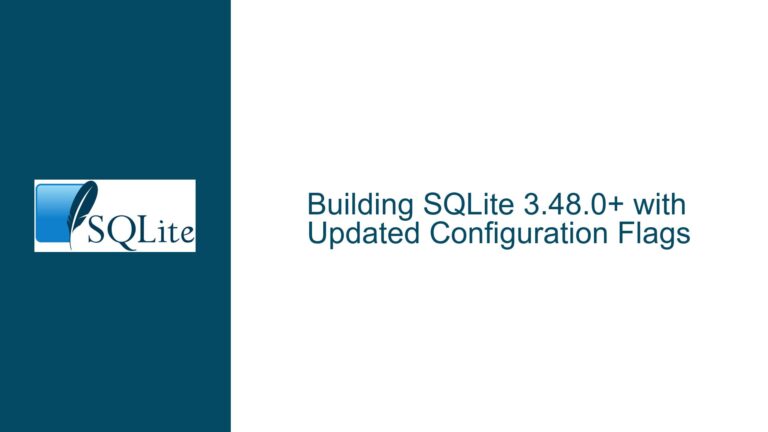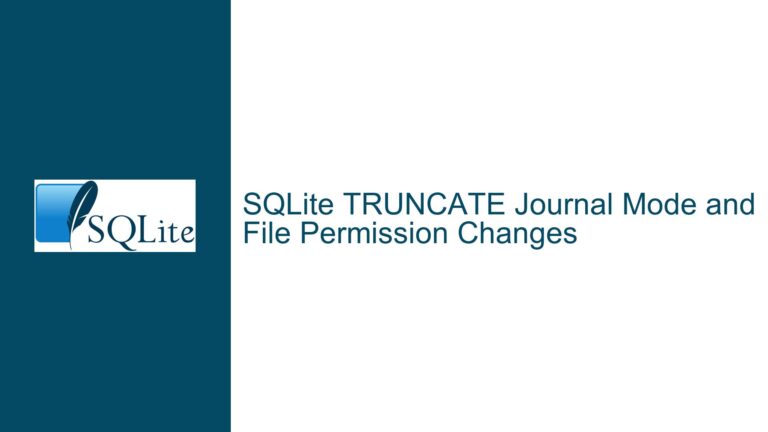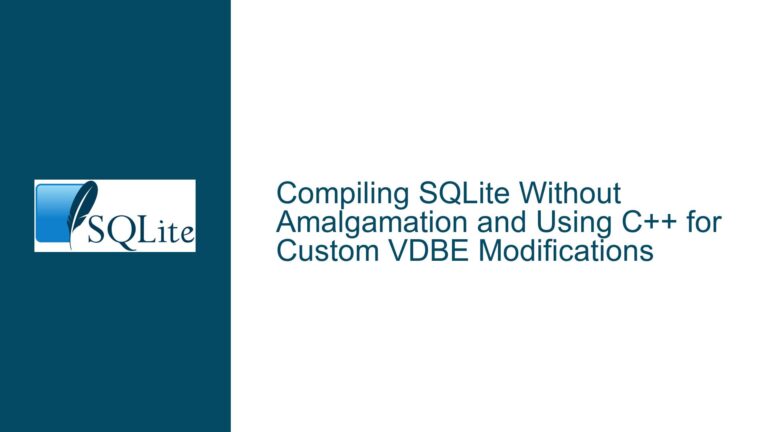SQLite Crash on INSERT into Ill-Formed View with COLLATE TRUE
Issue Overview: SQLite Crash Due to Ill-Formed View Definition and INSERT Operation
The core issue revolves around a crash in SQLite when attempting to execute an INSERT operation on a view that contains an ill-formed COLLATE clause. The view definition includes a CASE expression with a syntactically incorrect COLLATE TRUE clause, which should have been caught during the semantic analysis phase of query parsing. Instead of raising a syntax error, SQLite crashes when the INSERT operation is executed on this view. This crash occurs in both the latest unreleased trunk version (fossil commit: ac7359b263) and the released version 3.41.0 (fossil commit: 05941c2a04).
The crash manifests during the execution of the INSERT INTO view_2 DEFAULT VALUES RETURNING *; statement. The stack trace reveals that the crash occurs in the codeReturningTrigger function, which is part of the trigger handling mechanism in SQLite. The crash is triggered because the ill-formed view definition is not properly validated during the semantic analysis phase, leading to an invalid state when the INSERT operation is attempted.
The expected behavior is for SQLite to raise a syntax error during the parsing or semantic analysis phase when the view is defined, due to the invalid COLLATE TRUE clause. Instead, the ill-formed view is allowed to be created, and the crash occurs only when an INSERT operation is attempted on the view. This indicates a gap in the semantic validation of view definitions, particularly when COLLATE clauses are involved.
Possible Causes: Invalid COLLATE Clause and Lack of Semantic Validation
The primary cause of the crash is the ill-formed COLLATE TRUE clause in the view definition. The COLLATE clause is used in SQLite to specify a collation sequence for a column or expression. However, the TRUE keyword is not a valid collation name, and using it in this context is syntactically incorrect. The correct behavior would be for SQLite to raise a syntax error during the parsing or semantic analysis phase when the view is defined.
The crash occurs because the ill-formed view definition is not properly validated during the semantic analysis phase. Instead of raising a syntax error, SQLite allows the view to be created, and the crash only occurs when an INSERT operation is attempted on the view. This suggests that the semantic validation of view definitions, particularly when COLLATE clauses are involved, is incomplete or incorrect.
Another contributing factor is the handling of views in SQLite. In SQLite, views are virtual tables that are defined by a SELECT statement. When an INSERT operation is attempted on a view, SQLite checks if there is an INSTEAD OF INSERT trigger defined on the view. If no such trigger exists, SQLite should raise an error indicating that insertion into a view is not permitted. However, in this case, the crash occurs before this check can be performed, indicating that the ill-formed view definition is causing the crash during the trigger handling mechanism.
The crash is also related to the RETURNING clause in the INSERT statement. The RETURNING clause is used to return the values of the inserted rows, and it requires additional handling in the SQLite execution engine. The crash occurs in the codeReturningTrigger function, which is part of the trigger handling mechanism, suggesting that the ill-formed view definition is causing issues in the handling of the RETURNING clause.
Troubleshooting Steps, Solutions & Fixes: Addressing the Ill-Formed View and Improving Semantic Validation
To address this issue, several steps can be taken to ensure that SQLite correctly handles ill-formed view definitions and prevents crashes during INSERT operations.
1. Validate COLLATE Clauses During Semantic Analysis:
The first step is to ensure that COLLATE clauses are properly validated during the semantic analysis phase of query parsing. This includes checking that the collation name specified in the COLLATE clause is valid. If an invalid collation name is encountered, SQLite should raise a syntax error during the parsing or semantic analysis phase, rather than allowing the ill-formed view to be created.
2. Improve Handling of Views with Ill-Formed Definitions:
SQLite should be modified to handle views with ill-formed definitions more gracefully. This includes ensuring that the semantic validation of view definitions is complete and correct, particularly when COLLATE clauses are involved. If an ill-formed view definition is encountered, SQLite should raise an error during the view creation phase, rather than allowing the view to be created and crashing during subsequent operations.
3. Enhance Error Handling in the Trigger Mechanism:
The crash occurs in the codeReturningTrigger function, which is part of the trigger handling mechanism in SQLite. To prevent crashes in this scenario, the error handling in the trigger mechanism should be enhanced to handle cases where the view definition is ill-formed. This includes ensuring that the trigger mechanism can gracefully handle invalid view definitions and raise appropriate errors, rather than crashing.
4. Add Additional Test Cases for Ill-Formed View Definitions:
To prevent similar issues in the future, additional test cases should be added to the SQLite test suite to cover scenarios involving ill-formed view definitions, particularly those involving COLLATE clauses. These test cases should ensure that SQLite correctly raises syntax errors during the parsing or semantic analysis phase, rather than allowing ill-formed views to be created and crashing during subsequent operations.
5. Apply the Fix Provided by the SQLite Development Team:
The SQLite development team has already provided a fix for this issue, which ensures that the ill-formed view definition is properly validated during the semantic analysis phase. The fix can be found in the fossil commit 84417bbd144b2197. Applying this fix will prevent the crash and ensure that SQLite correctly raises a syntax error when an ill-formed view definition is encountered.
6. Review and Update Documentation:
The SQLite documentation should be reviewed and updated to provide clear guidance on the correct usage of COLLATE clauses in view definitions. This includes examples of valid and invalid collation names, as well as information on the expected behavior when an invalid collation name is encountered. This will help developers avoid common pitfalls and ensure that their view definitions are correctly formed.
7. Consider Adding a Linter or Static Analyzer for SQLite Queries:
To help developers catch issues with ill-formed view definitions and other SQLite queries, consider adding a linter or static analyzer that can be run as part of the development process. This tool could check for common issues, such as invalid COLLATE clauses, and provide warnings or errors before the queries are executed. This would help prevent issues from reaching production and improve the overall quality of SQLite queries.
8. Monitor for Similar Issues in Future Releases:
After applying the fix, it is important to monitor for similar issues in future releases of SQLite. This includes reviewing bug reports, analyzing crash reports, and conducting thorough testing of new features and changes. By staying vigilant, the SQLite development team can quickly identify and address any similar issues that may arise in the future.
9. Educate Developers on Best Practices for View Definitions:
Finally, it is important to educate developers on best practices for defining views in SQLite. This includes understanding the correct usage of COLLATE clauses, as well as other aspects of view definitions. By following best practices, developers can avoid common pitfalls and ensure that their views are correctly formed and function as expected.
In conclusion, the crash in SQLite when attempting to execute an INSERT operation on an ill-formed view is caused by a combination of an invalid COLLATE clause and incomplete semantic validation. By addressing these issues and implementing the recommended solutions, SQLite can be made more robust and reliable, ensuring that similar issues do not occur in the future. The fix provided by the SQLite development team is a crucial step in this process, and applying it will prevent the crash and ensure that SQLite correctly raises a syntax error when an ill-formed view definition is encountered.






